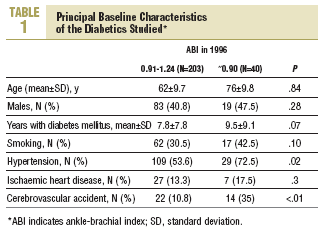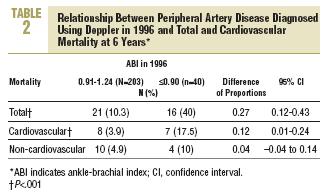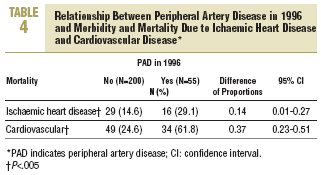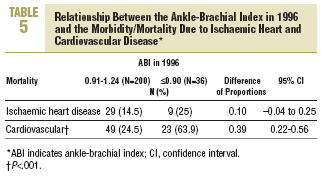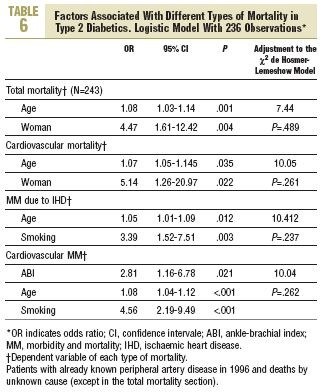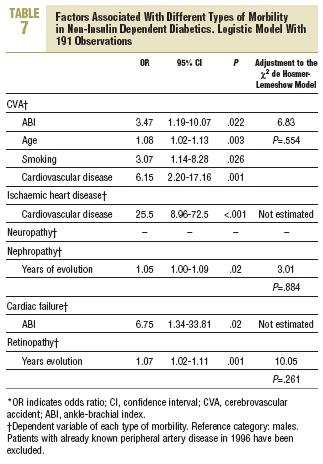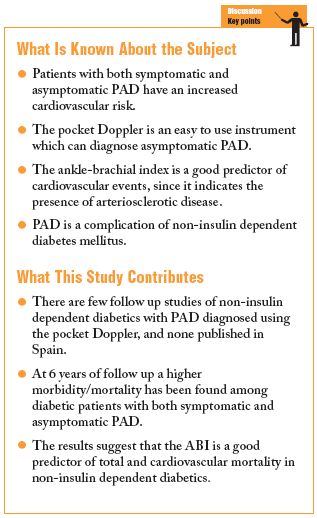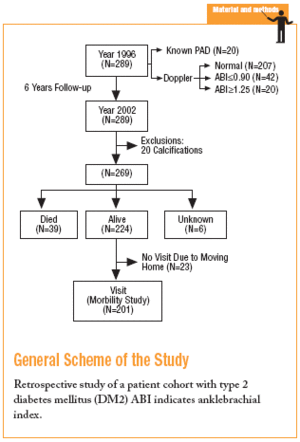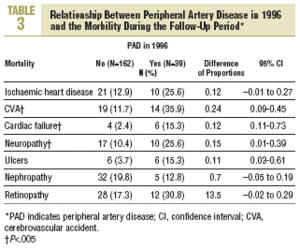¾ 0,90. Mediciones principales. Se citó a los pacientes para conocer la incidencia de eventos microvasculares y macrovasculares mortales y no mortales y se revisaron las historias. Se excluyó a 6 por no disponer de todos los datos. Resultados. Han fallecido 39 pacientes, 19 de los cuales presentaban AP en 1996 (30,1%) y 20 no (9,7%) (p = 0,001). Fallecieron 16 pacientes en el grupo con ITB ¾ 0,9 (30,2%) y 21 (10,1%) en el grupo con valores de ITB normales (p = 0,001). Murieron por causa cardiovascular 7 pacientes (13,2%) con ITB patológico y 8 (3,9%) con exploración normal (p = 0,009). La presencia de AP se ha asociado con una mayor probabilidad de presentar un episodio no mortal de cardiopatía isquémica (p = 0,04), un accidente cerebrovascular (ACV) (p < 0,001) y úlceras (p = 0,006). Un ITB bajo se ha asociado con una mayor probabilidad de presentar un evento cardiovascular, mortal o no (p < 0,001). Tras el análisis multivariable se observa un aumento de morbimortalidad cardiovascular (odds ratio [OR] = 2,81; intervalo de confianza [IC] del 95%, 1,16-6,78), ACV (OR = 3,47; IC del 95%, 1,19-10,07) e insuficiencia cardíaca (OR = 6,75; IC del 95%, 1,34-33,81) en los diabéticos con ITB ¾ 0,90. Conclusiones. Los diabéticos tipo 2 con AP presentan una mayor morbimortalidad. El ITB es un buen predictor de morbimortalidad cardiovascular e insuficiencia cardíaca.
Introduction
Peripheral artery disease (PAD) is the name given to arteriosclerotic disease of the lower limbs. Of the 3 important clinical manifestations of arteriosclerosis, it has the most benign prognosis, but it has already been observed in the Framingham study that patients with intermittent claudication had a risk of cardiovascular mortality twice as high as those patients of the same age and gender without claudication.1
Subsequent studies have also shown that asymptomatic PAD leads to an increased risk of presenting with cardiovascular events and total mortality.2-4
The pocket Doppler is an easy to use instrument and helps to make the diagnosis of PAD easier in the asymptomatic patient. With the help of a sphygmomanometer, it is possible to determine the systolic blood pressure (SBP) in the posterior brachial, pedis and tibial arteries and thus be able to calculate the ankle-brachial index (ABI).5,6 Many studies have been carried out to evaluate the validity of the ABI and its value as a predictor of total morbidity and mortality.2-4,7-9 The early diagnosis of PAD, when the patient is still asymptomatic, enables treatment to be started sooner and improves the prognosis.10,11
The calculation of the ABI can be particularly useful in the patient with type 2 diabetes mellitus (DM2), who has a high cardiovascular risk. PAD is one of the complications of DM2 and an etiological factor and poor prognosis of diabetes foot.12-16
Few studies have been published on the prevalence of PAD in patients with DM2 where the Doppler has been used, and even less follow up studies on these patients to find out their prognosis.17,18 For this reason, a study was carried out in Mataro (Spain) in 1996 with the objective of finding out the prevalence of PAD in patients cared for in the health centre with DM2.19 A Doppler examination was carried out on diabetics without known PAD, to calculate the ABI of each lower limb. The prevalence of PAD was found to be 21.4%, higher than that diagnosed previously (6.9%).
In 2002 we set out to find out the state of the patients studied in 1996 and we began a new study with the objective of assessing the morbidity and mortality of the patients with DM2 after 6 years as regards the presence or not of PAD, and the value of the ABI as a predictor of cardiovascular and total morbidity and mortality in DM2.
Sujects and Methods
It is a retrospective follow-up study of a cohort over 6 years.
The diabetics studied in 1996 participated in the study. Twenty patients who had signs of calcification, a fact that prevents finding out the intraluminal state of the arteries, were excluded. Also excluded were those diabetics who could not be located and those where it was not known whether they were alive or dead, and in the morbility study, those who had moved home and could not make the visit.
The data was collected from the 1st of July 2002 to the 28th of February 2003. An appointment was made with the patients and they all had an anamnesis performed, including a physical examination, an electrocardiogram, an ophthalmic examination, and a general laboratory analysis.
All the clinical histories were reviewed from when the Doppler examination was performed in 1996 up to the last visit to the centre and any new microvascular and macrovascular events were recorded.
The diagnostic criteria were the same as those used in 1996:
PAD: a well documented diagnosis in the clinical history or an ABI of ¾0.90 in at least 1 of the lower limbs.
Ischaemic heart disease: well documented episode of angina, acute myocardial infarction (AMI), or coronary surgical intervention.
Ischaemic cerebrovascular accident (CVA): a well documented episode of ischaemic CVA or a stenosis of the supra-aortic trunks of ¾50%.
Neuropathy: diagnosis present in the clinical history.
Cardiac failure: diagnosis present in the clinical history.
Nephropathy: confirmed presence of microalbuminuria (30-300 mg/24 h) or proteinuria (>300 mg/24 h) and/or creatinine >1.3 mg/dL.
Retinopathy: diagnosis made by an ophthalmologist.
Ulcers: recorded in the clinical history.
Non-fatal cardiovascular event: new diagnosis of PAD or ischaemic heart disease or non-fatal CVA.
Mortality: the passive files of the health centre and the only reference hospital (Mataro Hospital) were consulted to find out the cause of death of the patients who died during the study period. The causes were classified as: a) cardiovascular (AMI, ischaemic CVA, PAD, sudden death), and b) non cardiovascular (all the rest).
If the clinical histories were not found in the centre archives, the SIAP (Primary Care Computer System) database was consulted to find out if the patient had died or changed address.
The data was introduced into a computerised database and were analysed using the SPSS/PC, version 12 statistics program.
For the data analysis, the *2 test and binary logistic regression analysis (stepwise selection of the variables) were used. The variables introduced were: age, gender, years of evolution of the diabetes, blood pressure (BP), smoking habits, blood lipids, value of the ABI, and presence of cardiovascular disease in 1996 (known ischaemic heart disease, CVA, and PAD). As a test of goodness of fit, the Hosmer-Lemeshow test was used in all cases.
Patients without PAD in 1996 were compared with those who had PAD (well documented diagnosis in clinical history or ABI ¾0.90) and with those who had an ABI ç0.90.
Results
Of the 269 patients studied in 1996, 207 did not have PAD.
Of the 62 with PAD, 20 were previously diagnosed and 42 were diagnosed after an examination was made by Doppler. Table 1 shows the patient characteristics according to the ABI obtained. A higher prevalence of high BP and cerebrovascular disease was found among the patients with an ABI¾0.90.
Of the patients who did not have signs of calcification, the data of 6 were unknown, therefore they were excluded from the study (in 1996, 2 had a pathological ABI and 4 a normal ABI). The study of mortality was carried out with 263 diabetics.
Twenty three diabetics had moved home and were not able to come to the control visit, although it is known that they are alive. Of these, 2 belong to the known PAD group and 21 to the normal ABI group. There were no statistically significant differences between these patients and the patients in the study as regards age, gender, the presence of PAD, cardiovascular risk factors and the presence of ischaemic heart disease or CVA in 1996. After the exclusion, the morbility study was carried out with 201 diabetics.
Mortality
Of the total diabetic patients studied, 39 (14.8%) had died, of whom 19 (31.6%) had PAD in 1996 and 20 (9.8%) did not have PAD (P=.001). Twenty one patients had died due to a cardiovascular cause, 12 (57.1%) with PAD and 9 (42.8%) without PAD (P=.001).
Of the 40 patients who had died 16 (40%) had a pathological ABI (¾0.90), and 21 (10.3%) with a normal ABI (P=.001). Seven (17.5%) with a pathological ABI had died due to a cardiovascular cause and 8 (3.9%) with a normal ABI (Table 2)
No statistically significant differences were found in the non-cardiovascular deaths.
Morbility
Of the 201 patients who had been reviewed, those who had PAD in 1996 presented with a significantly higher number of ischaemic heart disease events (P=.04), CVA (P<.001), and ulcers (P=.006), as well as a higher probability of congestive heart failure (P=.001), neuropathy (P=.01), and retinopathy (P=.05). The differences were not significant for nephropathy (Table 3).
Morbidity and Mortality
On analysing the morbidity and mortality together, it was observed that 16 (29.1%) diabetics with PAD 1996 had a coronary event and 34 (61.8%) a cardiovascular event, as compared to 29 (14.6%) (P=.01) and 49 (24.6%) (P<.001) without PAD (Table 4). The patients who had a pathological ABI showed a higher probability of having a cardiovascular event (P<.001), but not a coronary one (Table 5).
In the multivariate analysis, a higher risk of cardiovascular morbidity and mortality (odds ratio [OR] =2.81; 95% confidence interval [CI], 1.16-6.78), CVA (OR=3.47; 95% CI, 1.19-10.07), and cardiac failure (OR=6.75; 95% CI, 1.34-33.81) was observed among the diabetics with an ABI¾0.90 (Tables 6 and 7). If the cardiovascular morbidity and mortality is analysed excluding the patients with known ischaemic heart disease, CVA and/or PAD in 1996, there is still an increased risk in patients with a pathological ABI (OR=3.01; 95% CI, 1.38-6.59; P=.006).
Discussion
The results obtained in our study show an increase in cardiovascular morbidity and mortality and total mortality in patients with PAD in 1996 and also in those who just had an ABI of ¾0.90.
The higher prevalence of high BP and cerebrovascular disease among patients with an ABI ¾0.90 has already been reported by other authors.8,9,17 On performing the multivariate analysis a higher risk of cardiovascular morbidity and mortality persists among patients with an abnormal ABI. We only know of 2 studies published on the prevalence and follow up of PAD in patients with DM2. Beach et al18 studied 252 diabetics using the ABI measurement and at 2 years of follow-up the mortality among diabetics with PAD was 22%, while in those who did not have PAD it was 4% (P=.0005). Kallio et al17 followed up 130 patients with NIDDM for 11 years and also found a higher mortality among those who had both symptomatic and asymptomatic PAD at the beginning of the study (58% compared to 16%; P=.001).
A large number of prospective studies have been carried out on non-diabetics that show a higher risk of cardiovascular and total mortality in patients with an ABI<0.90.2-4,20
As regards morbidity, we have found that the presence of PAD is associated with a higher probability of not only suffering from coronary or cerebrovascular disease already reported by other authors,20-23 but also a higher prevalence of congestive cardiac failure, retinopathy, and neuropathy. Although Dolan et al24 have already described the relationship between PAD and neuropathy, we know of no cohort study carried out only on patients with diabetes where the morbility associated to the presence or not of PAD was studied.
One of the weak points of the study is the losses that occurred over the 6 years. If we exclude the patients with signs of calcification, only 10.7% of the patients have been lost and 2% in the mortality study.
Another point of conflict is the evaluation of events retrospectively, since the data has been collected basically from the clinical history. However, we believe that the information gathered has been correct, since the health centre has a very stable health staffing levels, and only one reference hospital, which makes the follow up the patient easier.
Another limitation of the study is the number of cases, which was adequate to study the relationship of ABI with mortality but inadequate for the study of the morbility. It requires a follow-up with a much larger group of diabetics, as has been carried out on a general population, to find out the true value of the ABI as a predictor of complications in Type 2.
Important clinical studies have been published in recent years in the field of cardiovascular diseases. Some of them have newly introduced the use of ABI to make the diagnosis of PAD and to be able to analyse these patients within separate sub-groups, similar to that carried out with ischaemic heart disease and CVA.25 Others have considered PAD among the principal events studied26,27 and, along with other studies,28 they have also demonstrated the efficacy of the strict control of risk factors for arteriosclerosis in these patients. These studies are the ones that have led to the publication of the most important recommendations for the prevention and treatment of cardiovascular disease by advising the application of secondary prevention measures in the patient with PAD, both symptomatic as well as that diagnosed solely using the ABI.29-31 The American Heart Association32 recommends measuring the ABI on all those over 50 years old, with the intention of identifying patients with a high cardiovascular risk and thus be able to treat them more
aggressively, and also to be more active in looking for coronary and cerebral disease.
All this data leads us to emphasise the importance of incorporating the Doppler into Primary Care clinics, thus being able to identify, with a simple examination, the patients with a higher cardiovascular risk and be able to offer them a treatment which has shown to be efficient.








